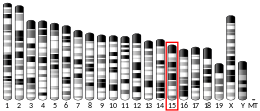LAPTM4B
Lysosomal-associated transmembrane protein 4B is a protein that in humans is encoded by the LAPTM4B gene.[5]
LAPTM4B protein contains a lysosome localization motif and localizes on late endosomes and lysosomes.
Clinical significance
Increased expression of LAPTM4B has been found in breast, liver, lung, ovarian, uterine, gastric cancers. Elevated LAPTM4B level contributes to chemotherapy resistance in breast cancer. It was found that overexpression of LAPTM4B causes anthracyclines (doxorubicin, daunorubicin, and epirubicin) resistance by retaining drug in the cytoplasm and decreasing nuclear localization of drug and drug induced DNA damage.[6]
In 2011, the same group reported that LAPTM4B also promotes autophagy, a cell survival mechanism mediated by lysosomes. LAPTM4B promotes autophagy and renders tumor cells resistant to metabolic and genotoxic stress and results in more rapid tumor growth.[7]
Based on these findings, LAPTM4B can be utilized to be a therapeutic target to prevent chemotherapy resistance or a marker to identify the patients who will not benefit from anthracyclines.[6]
References
- GRCh38: Ensembl release 89: ENSG00000104341 - Ensembl, May 2017
- GRCm38: Ensembl release 89: ENSMUSG00000022257 - Ensembl, May 2017
- "Human PubMed Reference:". National Center for Biotechnology Information, U.S. National Library of Medicine.
- "Mouse PubMed Reference:". National Center for Biotechnology Information, U.S. National Library of Medicine.
- "Entrez Gene: LAPTM4B lysosomal associated protein transmembrane 4 beta".
- Li Y, Zou L, Li Q, Haibe-Kains B, Tian R, Li Y, Desmedt C, Sotiriou C, Szallasi Z, Iglehart JD, Richardson AL, Wang ZC (February 2010). "Amplification of LAPTM4B and YWHAZ contributes to chemotherapy resistance and recurrence of breast cancer". Nat. Med. 16 (2): 214–8. doi:10.1038/nm.2090. PMC 2826790. PMID 20098429.
- Li Y, Zhang Q, Tian R, Wang Q, Zhao JJ, Iglehart JD, Wang ZC, Richardson AL (December 2011). "Lysosomal transmembrane protein LAPTM4B promotes autophagy and tolerance to metabolic stress in cancer cells". Cancer Res. 71 (24): 7481–9. doi:10.1158/0008-5472.CAN-11-0940. PMC 3261660. PMID 22037872.
Further reading
- Hartley JL, Temple GF, Brasch MA (2001). "DNA cloning using in vitro site-specific recombination". Genome Res. 10 (11): 1788–95. doi:10.1101/gr.143000. PMC 310948. PMID 11076863.
- Wiemann S, Weil B, Wellenreuther R, et al. (2001). "Toward a catalog of human genes and proteins: sequencing and analysis of 500 novel complete protein coding human cDNAs". Genome Res. 11 (3): 422–35. doi:10.1101/gr.GR1547R. PMC 311072. PMID 11230166.
- Strausberg RL, Feingold EA, Grouse LH, et al. (2003). "Generation and initial analysis of more than 15,000 full-length human and mouse cDNA sequences". Proc. Natl. Acad. Sci. U.S.A. 99 (26): 16899–903. doi:10.1073/pnas.242603899. PMC 139241. PMID 12477932.
- With S, Rice T, Salinas C, Auld V (2003). "Fire exit is a potential four transmembrane protein expressed in developing Drosophila glia". Genesis. 35 (3): 143–52. doi:10.1002/gene.10177. PMID 12640618.
- Shao GZ, Zhou RL, Zhang QY, et al. (2003). "Molecular cloning and characterization of LAPTM4B, a novel gene upregulated in hepatocellular carcinoma". Oncogene. 22 (32): 5060–9. doi:10.1038/sj.onc.1206832. PMID 12902989.
- Liu XR, Zhou RL, Zhang QY, et al. (2004). "Structure analysis and expressions of a novel tetratransmembrane protein, lysosoma-associated protein transmembrane 4 beta associated with hepatocellular carcinoma". World J. Gastroenterol. 10 (11): 1555–9. PMID 15162524.
- Gerhard DS, Wagner L, Feingold EA, et al. (2004). "The status, quality, and expansion of the NIH full-length cDNA project: the Mammalian Gene Collection (MGC)". Genome Res. 14 (10B): 2121–7. doi:10.1101/gr.2596504. PMC 528928. PMID 15489334.
- Wiemann S, Arlt D, Huber W, et al. (2004). "From ORFeome to biology: a functional genomics pipeline". Genome Res. 14 (10B): 2136–44. doi:10.1101/gr.2576704. PMC 528930. PMID 15489336.
- Kasper G, Vogel A, Klaman I, et al. (2005). "The human LAPTM4b transcript is upregulated in various types of solid tumours and seems to play a dual functional role during tumour progression". Cancer Lett. 224 (1): 93–103. doi:10.1016/j.canlet.2004.10.004. PMID 15911104.
- Otsuki T, Ota T, Nishikawa T, et al. (2007). "Signal sequence and keyword trap in silico for selection of full-length human cDNAs encoding secretion or membrane proteins from oligo-capped cDNA libraries". DNA Res. 12 (2): 117–26. doi:10.1093/dnares/12.2.117. PMID 16303743.
- Mehrle A, Rosenfelder H, Schupp I, et al. (2006). "The LIFEdb database in 2006". Nucleic Acids Res. 34 (Database issue): D415–8. doi:10.1093/nar/gkj139. PMC 1347501. PMID 16381901.
- Maeda K, Horikoshi T, Nakashima E, et al. (2007). "MATN and LAPTM are parts of larger transcription units produced by intergenic splicing: intergenic splicing may be a common phenomenon". DNA Res. 12 (5): 365–72. doi:10.1093/dnares/dsi017. PMID 16769693.
- Liu Y, Zhang QY, Qian N, Zhou RL (2007). "Relationship between LAPTM4B gene polymorphism and susceptibility of gastric cancer". Ann. Oncol. 18 (2): 311–6. doi:10.1093/annonc/mdl394. PMID 17074969.



